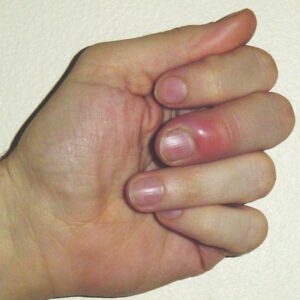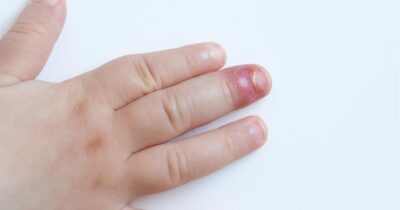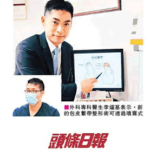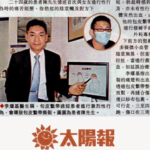

What is Paronychia? What is Periungual abscess?
Paronychia is an infection and inflammation of the skin caused by bacteria or fungi around the fingernails or toenails. Paronychia usually develops around the skin at the edge of the nail and usually does not affect the distal end of the nail. Early paronychia causes mild redness, mild localized warmth, mild swelling, and mild pain or discomfort around the nail. Acute paronychia usually develops within hours or days; chronic paronychia usually lasts for more than a few weeks.
If acute paronychia is left untreated, a periungual abscess may form. A periungual abscess is a pus-filled pocket that forms on the side or proximal part of the nail. A periungual abscess will cause obvious and severe swelling, redness, increased local temperature and tenderness, and difficulty in using the affected finger or toe.
When the nail fold skin is damaged, infection or inflammation can occur when bacteria, fungi, or irritating chemicals enter the wound. Common causes include:
- Biting nails
- Cutting nails too short
- Excessive exposure of hands to moist environments (including frequent finger sucking)
- Ingrown toenails
- Minor trauma to nails
Acute Paronychia
Acute paronychia usually develops over hours or days. If left untreated, it will become an increasingly painful swelling around a single fingernail or toenail, and a collection of pus may form an abscess. Immediate treatment (oral and topical antibiotics +/- surgical treatment) can reduce symptoms and lead to relatively quick recovery. If treated early, patients can recover within one to two weeks.
Chronic Paronychia
Chronic paronychia usually develops slowly and becomes more severe and more widespread around the affected fingers or toes. Chronic paronychia can affect multiple fingers or toes at the same time. It is often caused by more than one factor, e.g., mechanical damage, chemical irritation, bacterial infection, fungal infection, etc., on the nail edge. Other risk factors include:
- Certain occupations (e.g., housewife, dishwasher, bartender, sushi chef)
- Taking certain medications (e.g., steroids, immunosuppressants)
- Immunocompromised patients (e.g., diabetes, AIDS, cancer, systemic lupus erythematosus)
It can also occur after acute paronychia. This condition can be cured with oral medications, topical medications, and protecting the nail for weeks or months. Chronic inflammation can cause pyogenic granuloma.
Periungual Abscess
If treatment of acute paronychia is delayed, a collection of pus will form and a periungual abscess will develop. Immediate treatment (oral and topical antibiotics + surgery) can reduce symptoms and lead to relatively quick cure. If treated early, patients can recover within 1 to 3 weeks.
Symptoms and Signs
Most of the symptoms of paronychia are similar to those of a skin infection, while others are specific to the nail.
Symptoms of Paronychia/Periungual Abscess include:
- Swelling, redness, local temperature increase, local tenderness, difficulty in daily activities of the affected fingers or toes, etc.
- Abscess/abscess rupture and discharge of pus
- Nail hardening
- Deformed or damaged nails
- Separation of nails and nail bed
Diagnosis
Treatment
Acute Paronychia
If acute paronychia is treated early (with oral and topical antibiotics), patients can recover within one to two weeks. Antibiotics kill disease-causing bacteria.
Acute paronychia together with periungual abscess requires surgical treatment. Simple needle puncture of the abscess will not cure the periungual abscess. Under local anesthesia or general anesthesia, an experienced surgeon will incise the abscess, drain the pus, and remove the necrotic tissue within the abscess. After surgery, clean the wound with disinfectant every day, take oral antibiotics, and apply antibiotic ointment topically. Acute paronychia and periungual abscess will usually be cured within 1 to 3 weeks.

Chronic Paronychia
Chronic paronychia is usually caused by one or more fungi or bacteria. Doctors will prescribe antifungal medication and antibiotic medication. These drugs are taken orally and applied locally for a minimum of 1 to 4 months. It is important to keep the hands dry and clean throughout. Avoid thumb sucking and nail biting. Wear single-use gloves if possible. If a person’s job requires their hands to be wet, they may need to take some time off, change their workflow, or change their jobs.
Prevention
Patients’ Self Care
Patients’ self care is the most important element in curing and preventing paronychia:
- Always keep your hands warm, clean, and dry. Protect the nail fold with Vaseline after washing the hands.
- Wear waterproof gloves for any tasks involving irritants and chemicals.
- Avoid submerging the hands in water for long periods of time.
- Avoid biting your nails, manicuring your nail folds, and pushing back the cuticles.
- Avoid minor nail trauma.
- Do not use nail polish or apply false nails until the condition is cured.
- Occasionally, a change of workflow or occupation may be considered.
















